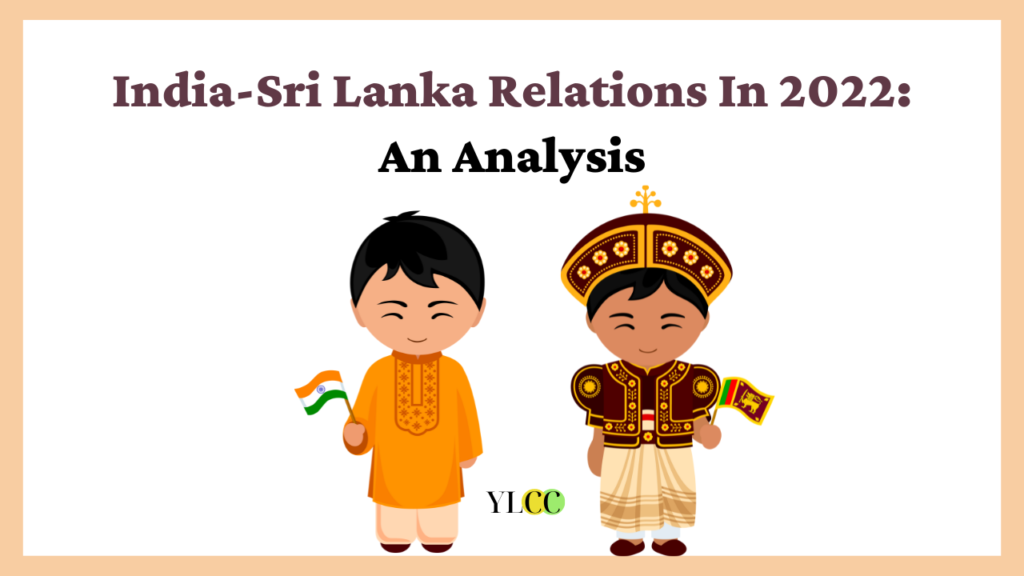
INTRODUCTION
Sri Lanka has been one of India’s closest neighbours in terms of the diplomatic and political alliance as well as the social and cultural backgrounds. Separated by the Palk Strait, the two countries have shared a rich and bountiful history going back thousands of years. Sri Lankan politics and administration is just as much influenced by its own cultures and traditions as it is by the shared ones between itself and India. A glaring testament to this fact is that the national anthem of Sri Lanka has been composed by a certain disciple of Rabindranath Tagore who was so inspired in his rather short stay at Tagore’s Visva-Bharti University that he went back to the island and began a cultural shift in the Sinhalese music. Tagore himself played a vibrant and robust role in expanding and expounding religious, cultural, educational, and artistic elements.
In this article, Team YLCC brings you a comprehensive overview of the ties between India and Sri Lanka in recent times. Read on!
A BRIEF BACKGROUND OF THE TIES BETWEEN INDIA AND SRI LANKA
While the histories of the two countries goes back in time to the Ashoka Empire which began the cultural and intellectual bond between the two sets of peoples. To this day, it remains India’s closest maritime neighbour with the distance a mere thirty nautical miles.
Indian presence has been prevalent in Sri Lanka to not only dispel their decades-long internal conflict between the Tamils and the Sinhalese but also diplomatic and financial wherein there have been several instances of the respective high commands meeting and coming to an amicable solution and the treasuries being lent to help the latter during their lean years. In the 1980s, the relations soured between the two countries due to the Tamil militant separatism who wished to create a sovereign within the island. The Liberation Tigers of Tamil Eelam (LTTE) was having a militaristic confrontation with the Indian Peace Keeping Force which was used to dispel the internal issues. The peak of the confrontation led to the assassination of the then Prime Minister, Rajiv Gandhi. Finally, in 2009, after quarter of a century of haggling, the governments via collective action finally dispelled and dispersed the secretariats but even today, the remnants of the faction affect grassroots Sri Lankan and Tamil Nadu politics.[1]
ANALYSIS OF THE RELATIONS BETWEEN INDIA AND SRI LANKA IN 2022
It has been, without any doubt, one of the worst years for Sri Lanka and its populace ever since it gained independence in 1948. There had been several reassurances given by the political leaders and the treasury officials of the Central Bank of Sri Lanka. The alarm was rung for the citizenry when the high command accepted that they had run out of all foreign exchange currencies. In March of 2022, there were several hours of power cuts, a struggle to ensure Balance of Payments (BoP) after it lost billions of dollars from its tourism sector due to COVID-19. The International Monetary Fund had stringently decided not to assist Sri Lanka due to its depleting repayment ability as predicted by international financial experts. With a struggling credit rating, the authorities in the island turned to its nearest important neighbour to ask for loans and bail-outs to help the citizens from burgeoning depravity and impoverishment.[2]
Following the unprecedented economic crisis that befell Sri Lanka, India extended a credit worth USD 4 billion to help counter the disastrous impact of the financial downfall. The Indian line of credit was used for doors, fuel, fertilisers and medicines to help the needy and ensure a sense of parity and balance is maintained amongst the citizenry.[3]
This has been followed closely on the heels of the “Neighbourhood First” international policy and diplomacy used by the current administration and championed by the incumbent. India realises its significance in the South Asian political scenario and has been on the forefront of not only being a beacon of help but also as a counter to the ever-increasing strategic and geo-political competition posed by China.
Finally, this year has been pivotal in another dimension which transcends the political and economic advancements. Since the end of the liberation struggle between the forces of India and the Separatists, there have been several people who have been internally displaced. Internal dispersion is characterised as the loss of the sense of being due to hugely traumatic experiences of the people resulting in the loss of their livelihood and home. India’s contribution to these Internally Displaced Persons (IDP) have been tremendously helpful with thousands of relief packs, establishment of medical units and provisions of temporary housing followed by starter packs to renew the agricultural activities. The commitment to better the lives and livelihoods of the displaced peoples has been undertaken since the restoration process began under the previous administration and has been scaling new heights since.[4]
CHALLENGES FACED IN THIS YEAR AND POTENTIAL HURDLES MOVING FORWARD
The biggest challenge that India faced in the year 2022 was the prevalence and active participation of China in the repatriation and restoration process. Sri Lanka had asked for a line of credit to be established between themselves and China just as it had done with India to further the hep which they can receive and use for their own benefit. Barring the recent political and financial struggle, Sri Lanka’s presence in the maritime sector remains one of the most important strongholds for India, internally as well as externally in the multi-national associations. Sri Lanka is also a major player in the BIMSTEC and SAARC regional associations wherein the dominance and autocratic rule of China has to be strategically and cautiously countered.
Another challenge in the coming years could be the burden on Sri Lanka to navigate the troubled waters of international diplomacy without succumbing to the authoritarian expectations and turning a close maritime ally like India into a foe with cumbersome relations and ties. Internal security and stability trumps all other expectations at this stage of Sri Lanka’s political and diplomatic ambitions and the extension of political, social, financial and economic help provided by India must be looked at not as a helpline but a diplomatic borrowing of a future favour.
CONCLUSION
The relation between India and Sri Lanka can sufficiently be summed up as one of immense cultural and social similarity which, however, has been greatly reducing in its shape and form as the years of instability and indecisiveness increase creating a situation where political commentators and experts begin questioning the efficiency and wisdom in the outflow of credit without a guarantee of repayment in the same enthusiastic manner. The glaring fault lines which were widened and the regionalism coupled with sectarianism which was fostered by the Rajapaksa family[5] has made the populace of the island be united in their fervent demand to make changes that are going to look at the positive and proactive correction of mistakes and laying the foundation for a strong base unaffected by internal rebel groups or external currencies to bail the country out of yet another financial disaster.
[1] India Sri Lanka Relations, Magadh University, https://www.magadhuniversity.ac.in/download/econtent/pdf/INDIA%20SRI%20LANKA%20FINAL%20LECTURE-converted.pdf
[2] Umesh Moramudalli, China, India, Sri Lanka’s Unprecedented Economic Crisis, The Diplomat, https://thediplomat.com/2022/03/china-india-and-sri-lankas-unprecedented-economic-crisis/
[3] Vikram Raina, India-Sri Lanka Relations in the Wake of Sri Lankan Economic Crisis: Analysis and Way Forward, Centre for Land Welfare Studies, https://www.claws.in/static/IB-366_India-Sri-Lanka-Relations-in-Wake-of-Sri-Lankan-Economic-Crisis-Analysis-and-Way-Forward-1.pdf
[4] India and Sri Lanka Relations, Ministry of External Affairs, https://www.mea.gov.in/Portal/ForeignRelation/Sri_Lanka_January_2014.pdf
[5] Nirupama Subramanian, Ethnic Fault-Lines Blur as Nation Unites in One Cry: Go Gota Go, The Indian Express, https://indianexpress.com/article/world/express-lanka-ethnic-fault-lines-blur-as-nation-unites-7861996/lite/
YLCC would like to thank its Content Team for their valuable insights in this article.






